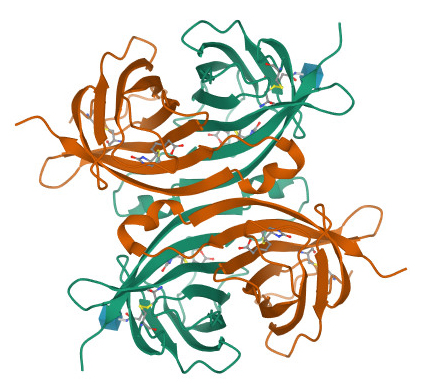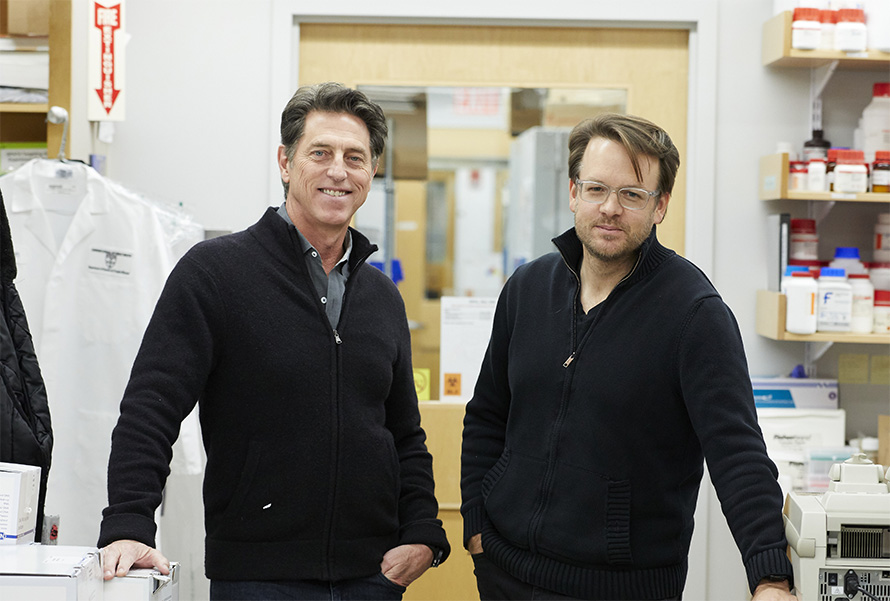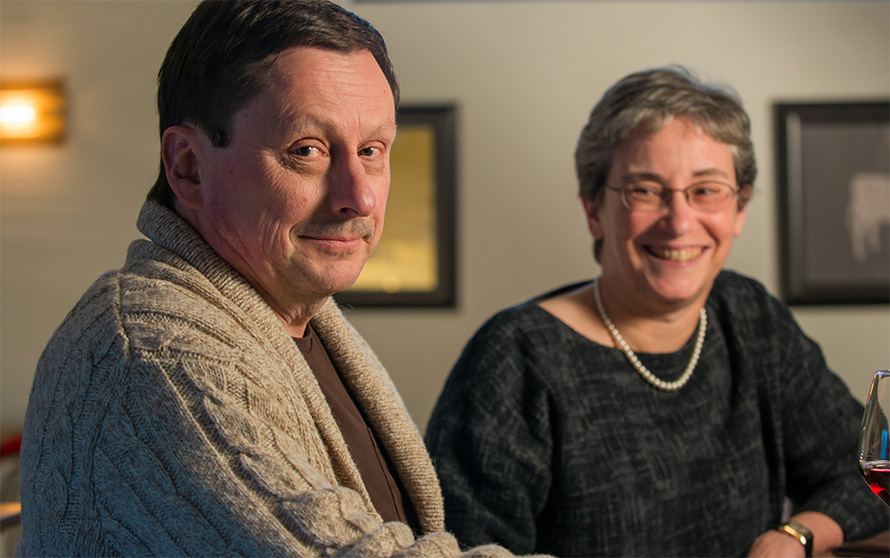
High-affinity binding
As medical residents in the late 1960s, Joseph Goldstein and Michael Brown would linger in the hospital cafeteria late at night after finishing their rounds. Sitting together after a long day, they’d talk about their patients, asking: Why? What’s causing the symptoms we see?

of colleagues stick together for good. DOI:10.2210/pdb1AVD/pdb
Some colleagues simply click. In science, such interactions are usually short-lived, though sometimes, as people follow their individual career paths, they find ways to work together again as collaborators.
Very rarely, two people decide to prioritize their working relationship over other opportunities, and they throw in their lots together. These partnerships can last for decades: Brown and Goldstein have run a lab at the University of Texas Southwestern Medical Center for 50 years, publishing hundreds of papers together and sharing the 1985 Nobel Prize in physiology or medicine.
Principal investigators who run labs jointly say this structure makes for a more fruitful creative process and a better distribution of heavy workloads. Approached mindfully, a joint lab can be less hierarchical, encouraging trainees as well as professors to talk over ideas in depth. And having a scientific partner for the long haul can help to even out the ebb and flow of institutional knowledge as shorter-term trainees pass through.
But professorial partnerships can be challenging to maintain. Academia generally is not set up to appreciate close working relationships between equals or to fund two investigators’ salaries for a single lab. Most prizes and hiring and promotion committees valorize the individual leader, and uneven recognition for evenly split work can tank a creative partnership.
Nevertheless, according to some observers, more two-PI laboratories exist today than ever before. What makes people choose to work so closely together? How do scientists structure and maintain these close working partnerships, and what do they gain from them?
ASBMB Today interviewed five pairs of PIs who came to lead joint labs through a variety of paths. Here’s what they told us.
A creative duo
When prospective postdocs interview with Tobi Walther and Bob Farese Jr. about becoming part of the Walther and Farese lab, the candidates’ first question is often, “How does this work? And why would you do it?”
The broad answer: The way it works is that they co-mentor everyone. And they do it both because it’s fun and because they find that they do better science together than apart. Still, Walther said, the questions can be tough to answer in detail because, in contrast to matters of scientific fact, “With questions of how to do things — how to do policy, how to run a lab — there are many gray areas.”
Farese and Walther recently chronicled lessons they’ve learned from nearly a decade running their lab together in the Journal of Clinical Investigation. They met when Farese, then a professor, spent a yearlong sabbatical in the lab where Walther was a postdoc. They worked productively together, investigating how lipid droplets form and grow.
After Farese returned to his own lab at the University of California, San Francisco, and Walther started as a group leader at the Max Planck Institute of Biochemistry and later at Yale, they continued to collaborate. As lipid biochemists, they always were aware of the Brown–Goldstein model for running a lab jointly. “But it would be a little far to say we had some master plan,” Walther said.

When an opportunity to join forces arose in 2014, the pair thought it over and decided to merge their labs in a move to the Harvard T.H. Chan School of Public Health. These days, they work in neighboring offices joined by a pocket door, and though both are heavily scheduled, they do their best to check in daily about goings-on in the lab.
They have been known to study other creative and business partnerships — including the Beatles’ John Lennon and Paul McCartney.
“One of the beauties of writing a song with another person is the product comes out different than either person would do by themselves — and hopefully better,” Farese said. “We experience that all the time. The work we do definitely comes out better than it would have been with one of us or the other of us.”
Creativity involves generating a lot of ideas and hypotheses. But not all of them will be good. “Some people think the correctness of an idea somehow scales with the authority of the person that utters it — which is often wrong,” Walther said. “My ideas can be just as stupid and wrong as someone else’s.”
Even so, employees tend to defer to their bosses. As peers, Walther and Farese more freely disagree over how to interpret data or the next step in a project — and this opens space in the lab’s culture for others to disagree with them as well.
Lately, the lab has studied sphingolipid accumulation in frontotemporal dementia: a subject that combines Walther’s expertise in biochemistry and membrane trafficking and Farese’s training in medicine. Either of them could have learned enough to lead the project on his own, Walther said. “But it’s just easier to do this way. And because it’s easier, it frees up creative processes that otherwise are much more difficult to access.”
Complementary intuition
When computer scientist Shantanu Singh talks about how well he knows his field, he doesn’t use the verbs “see” or “understand.” He says “to grok,” an expression coined in science fiction and beloved among geeks.
“The idea of grokking something in computer science is more than just understanding it. You’re almost a part of it,” Singh explained. “Maybe a less esoteric way of saying it is building intuition.”

and large imaging data sets, respectively, to guide their joint lab's research.
No one can develop that depth of knowledge about every field. But as co–principal investigators, Singh said, he and cell biologist Anne Carpenter apply their deep expertise in complementary fields to tackle problems from multiple angles: in their case, using machine learning and microscopy to classify cells.
Before they became peers, Singh trained with Carpenter, who directs the Broad Institute’s imaging platform. He arrived as a postdoc in computer science, stayed on as a staff scientist and eventually became a senior group leader, leading a subgroup embedded in the lab.
“I joined her lab, and I refused to leave,” Singh joked.
He became co-PI in 2021, and he credits Carpenter with the smoothness of the transition. With a consortium of industry and academic labs, they’re constructing a database of billions of cells’ responses to chemical probes and genetic manipulation.
When reviewing data, Singh said, Carpenter often has insight into whether gene clusters make sense. “And then I’ll have a much better intuition about whether the statistics that we’re doing or the computational methods could have caused some kind of bias.”
Together, they can suggest experiments to probe results and find out which preliminary observations hold up to closer scrutiny. Carpenter said in an email, “Our partnership works so well because we have enough overlapping knowledge to be able to translate well for each other.”
Team science is an important hallmark of the Broad Institute, Singh said. “Especially in this era, the low-hanging fruit is gone. … It’s going to be a multi-lab, multi-team effort to take on the big challenges.”
Finding the right institution
Some scientific partners are also life partners. That’s true of Joan and Ron Conaway, who ran a lab jointly from the beginning of their faculty career until last year.
“We used to jokingly refer to it as a mom and pop biochemistry shop,” Joan Conaway said.
The pair, who met as graduate students, had been married for about two years by the time Joan Conaway’s thesis adviser, Roger Kornberg, recommended that they team up to work on a project characterizing transcription initiation in mammalian cells. They were loath to divide the subject when the fellowship came to an end.
“The beauty of a partnership like this is that you don’t have to artificially divide the work,” Joan Conaway said. “You can follow the research where it goes and play off of each other’s strengths.”
After a brief stint at the University of Texas at Austin, where Ron Conaway was on the tenure track and Joan Conaway was not, the pair moved to the Oklahoma Medical Research Foundation and later the Stowers Institute.
“A lot of universities and research institutes wouldn’t hire two people to do the same thing,” Ron Conaway said. But they were able to find two long-term homes at which they could run their lab as equals. “In that sense, we were really lucky.”
The Conaways found that their working partnership was more supported at newer institutions that had greater financial flexibility and no rules preventing family members from working together.
Though their training was similar, the two have skills that played well off one another. She tended to enjoy working with — and troubleshooting — instruments. He liked writing the first drafts of grants and manuscripts based on their shared conversations.
Some opportunities over the years were poorly suited to accommodate a two-PI lab — for example, Joan Conaway was a Howard Hughes Medical Institute investigator for a time and Ron Conaway was not because the institute wouldn’t sponsor both of them at once. But they thought of it as a shared recognition and trusted one another not to compete. They also trusted that the community recognized their coequal contributions.
“For a long time, people referred to us as ‘les Conaways,’ as a team,” Ron Conaway said.
After they closed their lab at the Stowers Institute, Joan Conaway began work as a vice provost of the University of Texas Southwestern Medical Center. Ron Conaway has retired and is pursuing a longstanding interest in bioinformatics. While they find it strange to drive to work alone or to spend the day without a constant companion to bounce ideas off, the couple said, spending their days apart gives them much more to catch up on at home.
At UTSW, research partnerships abound, Joan Conaway said. “Here, it’s a way of life. Some institutions really get it, and others don’t.”

A better training environment
Like the Conaways, Patrick Lusk and Megan King became life partners and scientific partners at around the same time, when they were both postdocs. But after working closely together at that stage, they started independent labs at Yale in 2009. Although their labs were right next door to each other and worked on related problems, they seldom interacted professionally beyond an annual badminton tournament.
Lusk and King chose to merge labs about five years ago, in part because each noticed gaps in their mentoring style that the other could help to fill. Both agree that the best training environment for a young scientist combines experimental rigor and challenges with support and encouragement, and as principal investigators, each struggled to hit the right balance.
“My group meetings tended to be sort of nitpicky,” Lusk said, and although hearing and responding to constructive criticism is a key skill for a scientist, “people aren’t inspired by that. … They want to know what they’re working on has value.”
On the other hand, King had no trouble offering support, but pushing people didn’t come naturally to her. “Not challenging people holds people back, because you don’t provide them with the opportunity for growth,” she said.
During the merger, they renamed one lab space Vermont and the other Canada, after the places they grew up, and came up with the portmanteau LusKing to help end the friendly rivalry between the groups. They relied on Elisa Rodriguez, the joint lab’s manager, to combine operations such as ordering and tissue culture.
Rodriguez, who has worked with King since 2009, said that because King and Lusk are married with four children, “Obviously, they were already a team.”
Like co-parenting, Lusk and King said, running a lab together requires trust, mutual respect and a shared vision. But being partnered at home opens some unique pitfalls at work.
“It is very fraught,” King said. “We need to be particularly careful to ensure that we avoid triangulating and being seen as a monolith.”
Lusk and King always discuss managerial decisions in private, and they work hard to present a united front when giving difficult feedback. But on scientific questions, they find disagreements useful.
“Science can be emotional,” Lusk said. When trainees see him disagree with King about data “in a productive way, and everything’s fine afterwards, that models the way that we think science should be undertaken.”
When Lusk and King give contradictory advice about the best way forward, their graduate students make a decision with help from whichever one serves as their primary mentor. The postdocs, all of whom are jointly mentored, make a call on their own about what to prioritize. Sometimes a trainee will return to report that they did “the Patrick experiment” or “the Megan experiment.” But ultimately, Lusk said, developing a sense of judgment is a core part of scientific training. In the end, trainees do their own experiments.
Unconventional academic models
Having two PIs isn’t the only unusual thing about Omar Abudayyeh and Jonathan Gootenberg’s lab at the Massachusetts Institute of Technology. They also started it right after graduate school.
Abudayyeh and Gootenberg collaborated on CRISPR as graduate students with Feng Zhang. Both were interested in mining bacterial genomes for CRISPR–Cas systems and related enzymes and in developing new gene and cell engineering technologies.
Aware that the field was booming, they were reluctant to split up their productive partnership as they approached graduation. Who would hire two postdocs for one project — or allow a postdoc to collaborate closely with a rival lab in a competitive field? They found a solution when the McGovern Institute for Brain Research at MIT announced plans to launch a pilot program called the McGovern fellowship that would enable Ph.D. recipients to take a nontenured research group leader position.
Gootenberg and Abudayyeh are eager to remix academic norms. In their three years running what they call the AbuGoot lab, they have landed several National Institutes of Health grants and have spun off three companies using new CRISPR systems for diagnostics, genome editing and RNA targeting. They have found the biotechnology industry much more receptive to co-founders than academia is to co-PIs.
So far, the partnership has weathered challenges related to credit and recognition, such as the year when Abudayyeh was recognized on a “35 under 35” list and, because of editorial policies, Gootenberg was not. (Abudayyeh is quick to point out that the following year, Gootenberg landed on the same list.) Their philosophy is that any recognition either of them receives is good PR for the lab.
The two started the AbuGoot lab in 2019. To date, it remains the only lab the McGovern fellowship program supports. In answer to questions from ASBMB Today, a spokesperson for MIT wrote, “We have not developed a formal application program as of yet and we have not decided if the program will continue. We are not aware of additional labs run by two young scientists quite like this.”
When the McGovern funding concludes — the program officially provides three to five years of funding, but there doesn’t seem to be a formal end date — Abudayyeh and Gootenberg plan to seek opportunities to move the joint lab to a new institution. Although most departments don’t hire two people at once, Gootenberg said, “In general, it’s becoming more widespread, and people are understanding that unconventional academic models make sense. We have to experiment.”
Prospective partners
Although the number of jointly run labs seems to be increasing, it is still by no means a common path. For researchers who would like to run joint labs, the way forward is not obvious.
University of California, San Francisco, postdoctoral researcher Zara Weinberg aspires to start a lab someday with a close colleague from graduate school.
Like many of the joint PIs interviewed here, Weinberg has found that thinking through scientific questions with a partner is more fun than doing the same work on one’s own — and can yield better insights.
But she also observed that postdocs are under pressure to differentiate themselves in order to compete for too few faculty positions.
“There’s a huge emphasis on being singularly talented,” and, if you study subject X, “becoming ‘the X person,’” she said. That discourages close longitudinal collaborations.
No obvious pathways lead to a joint lab management situation, and it’s difficult to imagine making the funding work. Weinberg’s plan for now, she said, is to try to find a faculty job as an individual and hope that someday — if they both stay in science, if the money doesn’t run out — she and her colleague will be able to join forces.
Enjoy reading ASBMB Today?
Become a member to receive the print edition four times a year and the digital edition monthly.
Learn moreFeatured jobs
from the ASBMB career center
Get the latest from ASBMB Today
Enter your email address, and we’ll send you a weekly email with recent articles, interviews and more.
Latest in People
People highlights or most popular articles

Mapping proteins, one side chain at a time
Roland Dunbrack Jr. will receive the ASBMB DeLano Award for Computational Biosciences at the ASBMB Annual Meeting, March 7–10, just outside of Washington, D.C.

2026 voter guide
Learn about the candidates running for Treasurer-elect, Councilor and Nominating Committee.

Meet the editor-in-chief of ASBMB’s new journal, IBMB
Benjamin Garcia will head ASBMB’s new journal, Insights in Biochemistry and Molecular Biology, which will launch in early 2026.

Exploring the link between lipids and longevity
Meng Wang will present her work on metabolism and aging at the ASBMB Annual Meeting, March 7-10, just outside of Washington, D.C.

Defining a ‘crucial gatekeeper’ of lipid metabolism
George Carman receives the Herbert Tabor Research Award at the ASBMB Annual Meeting, March 7–10, just outside of Washington, D.C.

Nuñez receives Vallee Scholar Award
He will receive $400,000 to support his research.

